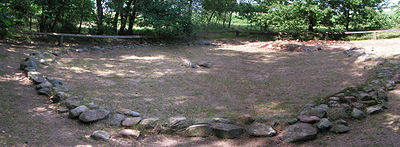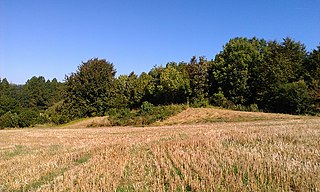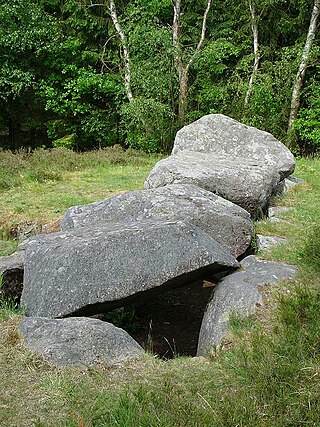Photos
 |  |
The Bonstorf Barrows (German : Grabhügelfeld von Bonstorf) are the remains of a much larger barrow cemetery on the Lüneburg Heath in north Germany dating to the late Neolithic or early Bronze Age. They are located east of the village of Bonstorf, part of the municipality of Hermannsburg in the Lower Saxon district of Celle. The site comprises six, closely packed burial mounds or barrows.
The largest barrow was located originally in a field, but due to its vulnerable location it was dug out in 1973 and reconstructed nearby. Of interest are the internal stones which were found in the burial mound. The barrow was surrounded by a stone circle.
Under the earth mound was a wooden chamber, in which a man had been buried in an east–west orientation. Grave items included an earthenware jar, a palstave, a sword and bronze dagger.
On the northern perimeter of the mound a woman was interred on a stone bed. She wore two, seven-ribbed bangles and a headdress made of clusters of small, sheet bronze pipes. Furthermore, a round bronze needle (Radnadel) lay on her chest. It is very likely that the woman had a personal relationship to the interred man.
The grave finds are characteristic of the old Bronze Age (i.e. from about 1500 to 1200 BC) in the Lüneburg Heath.
 |  |

Heidekreis is a district (Landkreis) in Lower Saxony, Germany. It is bounded by the districts of Harburg, Lüneburg, Uelzen, Celle, Hanover, Nienburg, Verden and Rotenburg.

A kurgan is a type of tumulus constructed over a grave, often characterized by containing a single human body along with grave vessels, weapons, and horses. Originally in use on the Pontic–Caspian steppe, kurgans spread into much of Central Asia and Eastern, Southeast, Western, and Northern Europe during the third millennium BC.

Duggleby Howe is one of the largest round barrows in Britain, located on the southern side of the Great Wold Valley in the district of Ryedale, and is one of four such monuments in this area, known collectively as the Great barrows of East Yorkshire. Duggleby Howe is believed on the basis of artefacts recovered to be of Late Neolithic date, but no radiocarbon dates are available. Howe as a place name is believed to have originated from the Old Norse word haugr.

A tumulus is a mound of earth and stones raised over a grave or graves. Tumuli are also known as barrows, burial mounds or kurgans, and may be found throughout much of the world. A cairn, which is a mound of stones built for various purposes, may also originally have been a tumulus.

A bowl barrow is a type of burial mound or tumulus. A barrow is a mound of earth used to cover a tomb. The bowl barrow gets its name from its resemblance to an upturned bowl. Related terms include cairn circle, cairn ring, howe, kerb cairn, tump and rotunda grave.

Julliberrie's Grave, also known as The Giant's Grave or The Grave, is an unchambered long barrow located near to the village of Chilham in the south-eastern English county of Kent. Probably constructed in the fourth millennium BCE, during Britain's Early Neolithic period, today it survives only in a state of ruin.

Amelinghausen is a municipality in the district of Lüneburg in Lower Saxony, Germany. It is also the seat of the collective municipality (Samtgemeinde) of Amelinghausen.

Norse funerals, or the burial customs of Viking Age North Germanic Norsemen, are known both from archaeology and from historical accounts such as the Icelandic sagas and Old Norse poetry.

The Egtved Girl was a Nordic Bronze Age girl whose well-preserved remains were discovered outside Egtved, Denmark in 1921. Aged 16–18 at death, she was slim, 160 centimetres (63 in) tall, had short, blond hair and well-trimmed nails. Her burial has been dated by dendrochronology to 1370 BCE. She was discovered together with cremated remains of a child in a barrow approximately 30 metres (98 ft) wide and 4 metres (13 ft) high. Only the girl's hair, brain, teeth, nails and a little of her skin remain preserved.

The Sieben Steinhäuser also Siebensteinhäuser is a group of five dolmens on the Lüneburg Heath in the NATO training area of Bergen-Hohne, in the state of Lower Saxony in northern Germany. The stones are considered to be part of the funnelbeaker culture. The gravesite was granted protected cultural monument status in 1923.

The Hochdorf Chieftain's Grave is a richly-furnished Celtic burial chamber near Hochdorf an der Enz in Baden-Württemberg, Germany, dating from 530 BC in the Hallstatt culture period. It was discovered in 1968 by an amateur archaeologist and excavated from 1978 to 1979 by the State Historical site office known as the Baden-Württemberg Landesdenkmalamt under the direction of German archeologist Jörg Biel with association from excavation technician Fritz Maurer. By then, the burial mound covering the grave, originally 6 m (20 ft) in height and about 60 m (200 ft) in diameter, had shrunk to about 1 m in height and was hardly discernible due to centuries of erosion and agricultural use.
Arzhan is a site of early Saka kurgan burials in the Tuva Republic, Russia, some 60 kilometers (40 mi) northwest of Kyzyl. It is on a high plateau traversed by the Uyuk River, a minor tributary of the Yenisei River, in the region of Tuva, 20 km to the southwest of the city of Turan.

The Südheide Nature Park is a large protected area of forest and heathland in the southern part of the Lüneburg Heath in North Germany. It has been designated as a protected nature park since 1964.

The dolmen on a low elevation between the villages of Dohnsen and Siddernhausen near the town of Bergen in North Germany, was originally 500 m further north. It was excavated in 1977 and reconstructed in its present location. This dolmen from the New Stone Age is believed to have been destroyed in the 17th or 18th century, because its large stones lay scattered on the fields. Several of the stones were sunk into the ground, others had been carried away. As a result, a considerable amount of the original material has been lost.

The Oldendorfer Totenstatt is a group of six burial mounds and megalith sites in Oldendorf north of Amelinghausen in the valley of the River Luhe in Lüneburg district in the German state of Lower Saxony. It consists of dolmens and tumuli.

Bonstorf is a village in the municipality of Südheide in the north of Celle district on the Lüneburg Heath in central Germany.
Beckedorf is a village and Ortschaft in the municipality of Südheide in northern Celle district in the German state of Lower Saxony. Situated on the western edge of the Southern Heath Nature Park in the Lüneburg Heath, about 1 km southwest of Hermannsburg itself, it currently has about 610 inhabitants. The name means "village on the Beke". In old records it can be found as Beketorpe, Bekendorpe or Beckedorp. In 1973 Beckedorf was incorporated into the parish of Hermannsburg as part of Lower Saxony's territorial and administrative reforms.

Wohlde is a hamlet in the parish of Dohnsen, that belongs to the Lower Saxon borough of Bergen in North Germany. It lies in the northern part of the district of Celle on the Lüneburg Heath, 1 km east of Bergen, at a height of 77 to 81 m above sea level (NN). The name is derived from Berger Wohld.

An Anglo-Saxon burial mound is an accumulation of earth and stones erected over a grave or crypt during the late sixth and seventh centuries AD in Anglo-Saxon England. These burial mounds are also known as barrows or tumuli.

The Necropolis of Soderstorf is a prehistoric cemetery in the valley of the Luhe river valley near Soderstorf in the Lüneburg district of Lower Saxony, Germany. The site was used for more than 2000 years. It includes a megalithic tomb, a tumulus tomb, a stone circle, paving stones, funerary urns and a flat grave.